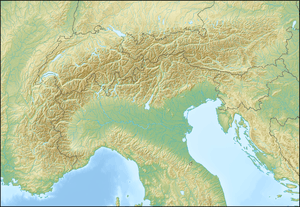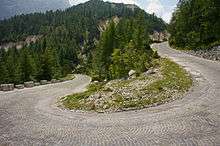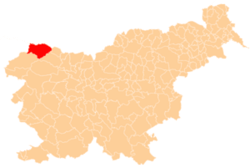Vršič Pass
| Vršič Pass | |
|---|---|
|
The Vršič Pass | |
| Elevation | 1,611 m (5,285 ft) |
| Traversed by | Ruska cesta |
| Location | Upper Carniola, Slovenia |
| Range | Julian Alps |
| Coordinates | 46°26′8″N 13°44′40″E / 46.43556°N 13.74444°ECoordinates: 46°26′8″N 13°44′40″E / 46.43556°N 13.74444°E |
 Vršič Pass Location of the Vršič Pass | |
The Vršič Pass (pronounced [ʋəɾˈʃitʃ]; Slovene: prelaz Vršič, Italian: Passo della Moistrocca, German: Werschetzpass),[1] with an elevation of 1,611 metres (5,285 ft), is a high mountain pass across the Julian Alps in northwestern Slovenia. It is the highest pass in Slovenia, as well as the highest in the Eastern Julian Alps. It connects Upper Carniola with the Trenta Valley in the Slovene Littoral. The road across the pass, now known as Russian Road (Ruska cesta), was originally built for military purposes in the early 19th century and followed an earlier trade route.[2] The Vršič Pass is considered an excellent starting point for excursions to surrounding peaks.
Name
The Slovene common noun vršič literally means 'little peak', a diminutive form of the word vrh 'peak'. The name originally referred to Mount Vršič (1,738 m or 5,702 ft), located about 200 m (660 ft) east of the Vršič Pass. The name Vršič was not applied to the pass until 1911. The name of the peak was first attested in written sources as Werschez in 1763–87. Locally, the pass is known as Na močilu (first attested in 1763–87 as Muschizach or Mushizhach).[3] The Italian name of the pass was Moistrocca.
History
After World War I, from 1918 to World War II, the Vršič Pass was on the border between Italy and Yugoslavia. Since 1945, together with the Upper Isonzo Valley north of Gorizia, it was incorporated in Yugoslavia, and then in Slovenia.
Hiking
The Vršič Pass is considered an excellent starting point for excursions to surrounding peaks, including Mala Mojstrovka (2,332 m or 7,651 ft), Velika Mojstrovka (2,366 m or 7,762 ft), Planja (2,453 m or 8,048 ft), Prisojnik (Prisank) (2,547 m or 8,356 ft), Razor (2,601 m or 8,533 ft), Šitna Glava (2,087 m or 6,847 ft), Slemenova Špica (1,911 m or 6,270 ft), Sovna Glava (1,750 m or 5,740 ft), and Suhi Vrh (2,109 m or 6,919 ft), or shorter hikes in the immediate area.
Several mountain lodges are located near the pass: the Erjavec Lodge (Erjavčeva koča; 1,515 m or 4,970 ft), the Tičar Lodge (Tičarjev dom; 1,620 m or 5,310 ft), Mike's Lodge (Mihov dom), the Forest Lodge (Koča na Gozdu; 1,226 m or 4,022 ft), and the Postman's Lodge (Poštarska koča; 1,725 m or 5,659 ft).
Road
The road through the pass rises from Kranjska Gora in a series of 50 hairpin bends, traverses the top of the Vršič Pass, and descends into the Soča Valley. The upper elevations of the road are rendered impassable by heavy snowfall during much of winter. The road was greatly improved in late 1915 to supply the Isonzo front of World War I, and it was originally named after Archduke Eugen of Austria-Hungary. The current name, Russian Road (Ruska cesta), refers to the approximately ten thousand Russian prisoners of war used as laborers in the 1915 construction.[2]
Monuments
Just off the main road, on the north side of the pass, at an elevation of around 1,200 m (3,900 ft), there is a Russian Orthodox chapel, built by the Russian POWs to commemorate their comrades who died during the road construction.
On the south side of the pass there is a bronze monument in honor of the mountaineer and writer Julius Kugy, work by the architect Boris Kobe and the sculptor Jakob Savinšek. It was erected in 1953.[4]
Gallery
- The Vršič Pass
- View from the Vršič Pass
 Ascending the road to the Vršič Pass, view of the 23rd switchback at 1,539 m above sea level
Ascending the road to the Vršič Pass, view of the 23rd switchback at 1,539 m above sea level The Russian Road; the switchbacks are paved with setts
The Russian Road; the switchbacks are paved with setts
See also
References
| Wikimedia Commons has media related to Vršič Pass. |
- ↑ Garwood, Duncan (2009). Mediterranean Europe. Lonely Planet. p. 724. ISBN 978-1-741-04856-8.
- 1 2 Pavšič, Gregor. 2016. Zgodba slovenskega prelaza, kjer so umirali Rusi. Siol.net (July 29).
- ↑ Snoj, Marko. 2009. Etimološki slovar slovenskih zemljepisnih imen. Ljubljana: Modrijan and Založba ZRC, p. 470.
- ↑ "4461: Trenta - Spomenik Juliusu Kugyju" [4461: Trenta – Monument to Julius Kugy]. Register nepremične kulturne dediščine [Registry of Immovable Cultural Heritage] (in Slovenian). Ministrstvo za kulturo Republike Slovenije. Retrieved 16 June 2015.

